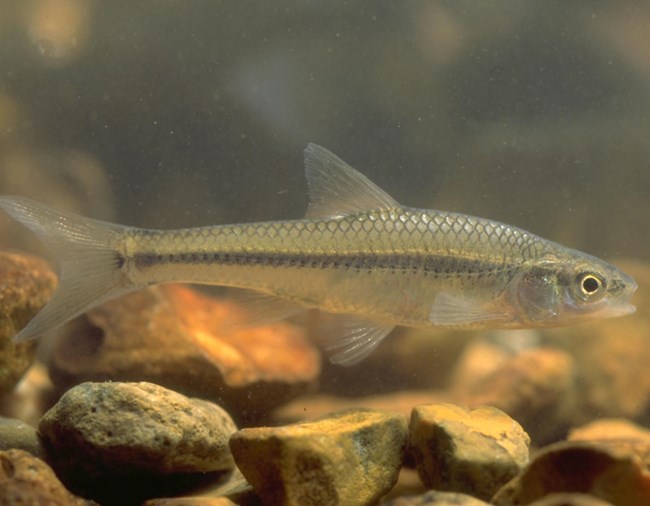Last updated: July 25, 2020
Article
Little Fish on the Prairie: The Tale of the Topeka Shiner

Photo by MDC Staff, courtesy Missouri Department of Conservation
What is a Topeka shiner?
The Topeka shiner (Notropis topeka) is a member of the cyprinid family and is a type of minnow. This small (< 3 inches) plains fish is silvery-green in color with a dark stripe, or lateral band, that runs the length of its body. The scales above the band are strongly cross-hatched, while those below have no pigment. During spawning, the fins of the male turn bright red-orange. This species can be distinguished from similar species by the dark chevron located at the base of its tail fin.
Where do they live?
Topeka shiner live in small to mid-size streams throughout the central prairie region. They prefer sand and gravel substrates, and cool, high-quality waters. Many existing populations are found in oxbows and off-channel pools. They usually inhabit areas containing sunfish, using and guarding sunfish nests as their own. First discovered near Topeka, KS, in 1884, they were historically widespread, though today they are found in smaller, disjunct populations.
Why is the Topeka shiner endangered? What protection do they have?
The Topeka shiner was federally listed as an endangered species in 1999 due to extensive habitat destruction, reduction in available groundwater sources, and non-native predation.
Threats to the Topeka shiner:
- Stream Channelization
- Dams & Impoundments
- Sedimentation & Oxbow Removal
- Gravel Removal Operations
- Agricultural Runoff
- Introduction of Non-Native Species
- Urbanization & Development
Federal Protections:
- Illegal to import, export, take, or sell Topeka shiner without proper permitting
- Penalties for harming and/or harassing
- Increased research & habitat studies
- Development of recovery plans
- Habitat management & protection
- Reintroduction efforts
How do we study Topeka shiner?
Fish sampling is performed in several different ways. In Topeka shiner habitat, trapping, seining, and backpack electrofishing tend to be most effective. In Pipestone National Monument, Pipestone Creek is considered critical habitat for this species.
What can I do to protect the Topeka shiner?
Landowners and concerned citizens can do their part to help conserve the Topeka shiner and its habitat:
- Restore natural stream systems
- Install vegetated buffers
- Manage livestock stream access
- Re-vegetate eroding banks
- Conserve soil within watersheds
- Support established conservation ..programs & report illegal activity
For more information on how you can help the Topeka shiner, contact the U. S. Fish & Wildlife Service or your local state wildlife agency.
Additional Resources:
https://www.fws.gov/midwest/endangered/fishes/topekashiner/tosh-qas.html
https://www.fws.gov/midwest/news/663.html
https://www.biologicaldiversity.org/species/fish/Topeka_shiner/index.html
https://www.fws.gov/midwest/endangered/fishes/topekashiner/tosh_mn.html
https://nature.mdc.mo.gov/discover-nature/field-guide/topeka-shiner
http://skralston.com/USFWS/Oxbow_Restoration_and_Monitoring_in_Prairie_Streams_for_Topeka_shiner_Recovery.pdf
https://www.dnr.state.mn.us/rsg/profile.html?action=elementDetail&selectedElement=AFCJB28960#
https://gfp.sd.gov/UserDocs/nav/TopekaShinerManagementPlan-Revised.pdf
